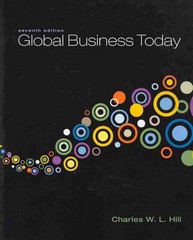Best known as one of the worlds largest producers of computer mice, Logitech is in many ways
Question:
Best known as one of the world’s largest producers of computer mice, Logitech is in many ways the epitome of the modern global corporation. Founded in 1981 in Apples, Switzerland, by two Italians and a Swiss, the company now generates annual sales of more than $2.2 billion, most from products such as mice, keyboards and low-cost video-cams. Logitech made its name as a technological innovator in the highly competitive business of personal computer peripherals. It was the first company to introduce a mouse that used infrared tracking, rather than a tracking ball, and the first to introduce the wireless mouse and keyboard. Logitech is differentiated from competitors by its continuing innovation, its high brand recognition, and strong retail presence. Less obvious to consumers, but equally important, has been the way the company has configured its global value chain to lower production costs while maintaining the value of those assets that lead to differentiation.
Logitech still undertakes basic R&D work (primarily software programming) in Switzerland where it has several hundred employees. The company is still legally Swiss, but most of the corporate functions are run out of offices in Fremont, California, close to many of America’s high-technology enterprises, where it has more than 500 employees. Some R&D work (again, primarily software programming) is also carried out in Fremont. Most significantly though, Fremont is the headquarters for the company’s global marketing, finance, and logistics operations. The ergonomic design of Logitech’s products—their look and feel—is done in Ireland by an outside design firm. Most of Logitech’s products are manufactured in Asia.
Logitech’s expansion into Asian manufacturing began in the late 1980s when it opened a factory in Taiwan. At the time, most of its mice were produced in the United States. Logitech was trying to win two of the most prestigious OEM customers— Apple Computer and IBM. Both bought their mice from Alps, a large Japanese firm that supplied Microsoft. To attract discerning customers such as Apple, Logitech not only needed the capacity to produce at high volume and low cost, bit it also had to offer a better-designed product. The solution: manufacture in Taiwan. Cost was a factor in the decision, but it was not as significant as might be expected, since direct labor accounted for only 7 percent of the cost of Logitech’s mouse. Taiwan offered a well-developed supply base for parts, qualified people, and a rapidly expanding local computer industry. As an inducement to fledgling innovators, Taiwan provided space in its Hsinchu Science and Industrial Park for the modest fee of $200,000. Sizing this up as a deal that was too good to pass up, Logitech signed the lease. Soon afterward, Logitech won the OEM contract with Apple. The Taiwanese factory was soon outproducing Logitech’s U.S. facility. After the Apple contract, Logitech’s other OEM business started being served from Taiwan; the plant’s total capacity increased to 10 million mice per year.
Questions
1. In a world without trade, what would happen to the costs that American consumers would have to pay for Logitech’s products?
2. Explain how trade lowers the costs of making computer peripherals such as mice and keyboards.
3. Use the theory of comparative advantage to explain the way in which Logitech has configured its global operations. Why does the company manufacture in China and Taiwan, undertake basic R&D in California and Switzerland, design products in Ireland, and coordinate marketing and operations from California?
4. Who creates more value for Logitech—the 650 people it employs in California and Switzerland, or the 4,000 employees at its Chinese factory? What are the implications of this observation for the argument that free trade is beneficial?
5. Why do you think the company decided to shift its corporate headquarters from Switzerland to Fremont?
6. To what extent can Porter’s diamond help explain the choice of Taiwan as a major manufacturing site for Logitech?
7. Why do you think China is now a favored location for so much high-technology manufacturing activity? How will China’s increasing involvement in global trade help that country? How will it help the world’s developed economies? What potential problems are associated with moving work to China?
Step by Step Answer:






